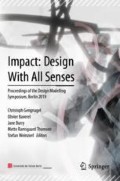Abstract
In this paper, we present a novel, speculative design approach for a bio-hybrid architectural system. The Living Weaves system seeks to harness the material accumulation capacity of climbing plants and steer this growth into an interlaced configuration with a diagrid scaffold to produce a structural Kagome weave. The concept is described through a speculative design proposal, and its feasibility is investigated in two ways; the development of an autonomous steering system to achieve interlacing of living plants with a diagrid scaffold, and an analytical design method for determining structurally advantageous plant growth routes in target geometries. Together, these two investigations represent steps towards a persistent modelling approach, which, we argue, is essential for exploiting the novel characteristics of living bio-hybrid architectures.
Access this chapter
Tax calculation will be finalised at checkout
Purchases are for personal use only
References
Ayres, P., Martin, A.G., Zwierzycki, M.: Beyond the Basket Case: a principled approach to the modelling of Kagome weave patterns for the fabrication of interlaced lattice structures using straight strips. In: Advances in Architectural Geometry 2018, pp. 72–93. Chalmers University of Technology (2018)
Mesnil, R., et al.: Linear buckling of quadrangular and Kagome gridshells: a comparative assessment. Eng. Struct. 132, 337–348 (2017)
Stolarz, M.: Circumnutation as a visible plant action and reaction: physiological, cellular and molecular basis for circumnutations. Plant Signal. Behav. 4(5), 380–387 (2009)
Ayres, P. (ed.): Persistent Modelling: Extending the Role of Architectural Representation. Routledge, Abingdon (2012)
Ayres, P.: Microstructure, macrostructure and the steering of material proclivities. In: Manufacturing the Bespoke, pp. 220–237. Wiley (2012)
flora robotica – societies of symbiotic robot-plant bio-hybrids as social architectural artifacts. http://www.florarobotica.eu. Accessed 05 June 2019
Elsacker, E., et al.: Mechanical, physical and chemical characterisation of mycelium-based composites with different types of lignocellulosic substrates. BioRxiv, p. 569749 (2019)
Vallas, T., Courard, L.: Using nature in architecture: building a living house with mycelium and trees. Front. Archit. Res. 6(3), 318–328 (2017)
Heisel, F., et al.: Design of a load-bearing mycelium structure through informed structural engineering. In: Proceedings of the World Congress on Sustainable Technologies (2017)
Ludwig, F., Schwertfreger, H., Storz, O.: Living systems: designing growth in Baubotanik. Archit. Des. 82(2), 82–87 (2012)
Fab Tree Hab. https://en.wikipedia.org/wiki/Fab_Tree_Hab. Accessed 29 Mar 2019
Wahby, M., et al.: Evolution of controllers for robot-plant bio-hybdrids: a simple case study using a model of plant growth and motion. In: Proceedings of the 25th Workshop on Computational Intelligence, pp. 67–86 (2015)
Wahby, M., et al.: An evolutionary robotics approach to the control of plant growth and motion: modeling plants and crossing the reality gap. In: 2016 IEEE 10th International Conference Self-Adaptive and Self-Organizing Systems (SASO), pp. 21–30 (2016)
Hofstadler, D., et al.: Evolved control of natural plants: crossing the reality gap for user-defined steering of growth and motion. ACM Trans. Auton. Adapt. Syst. (TAAS) 12(3), 15 (2017)
Wahby, M., et al.: Autonomously shaping natural climbing plants: a bio-hybrid approach. Roy. Soc. Open Sci. 5(10), 180296 (2018)
Acknowledgements
This work was supported by the European Union’s Horizon 2020 research and innovation program under the project flora robotica – FET grant agreement no. 640959.
Author information
Authors and Affiliations
Corresponding author
Editor information
Editors and Affiliations
Rights and permissions
Copyright information
© 2020 Springer Nature Switzerland AG
About this paper
Cite this paper
Ayres, P., Buchwald, E.F., Gatz, S., Bornaz, S. (2020). Living Weaves – Steps Towards the Persistent Modelling of Bio-Hybrid Architectural Systems. In: Gengnagel, C., Baverel, O., Burry, J., Ramsgaard Thomsen, M., Weinzierl, S. (eds) Impact: Design With All Senses. DMSB 2019. Springer, Cham. https://doi.org/10.1007/978-3-030-29829-6_35
Download citation
DOI: https://doi.org/10.1007/978-3-030-29829-6_35
Published:
Publisher Name: Springer, Cham
Print ISBN: 978-3-030-29828-9
Online ISBN: 978-3-030-29829-6
eBook Packages: EngineeringEngineering (R0)

